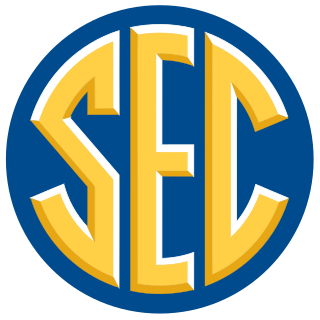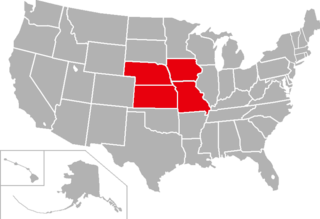Related Research Articles

The National Collegiate Athletic Association (NCAA) is a nonprofit organization that regulates student athletics among about 1,100 schools in the United States, and one in Canada. It also organizes the athletic programs of colleges and helps over 500,000 college student athletes who compete annually in college sports. The organization is headquartered in Indianapolis, Indiana.

The Southeastern Conference (SEC) is an American college athletic conference whose member institutions are located primarily in the South Central and Southeastern United States. Its fourteen members include the flagship public universities of ten states, three additional public land-grant universities, and one private research university. The conference is headquartered in Birmingham, Alabama. The SEC participates in the National Collegiate Athletic Association (NCAA) Division I in sports competitions; for football it is part of the Football Bowl Subdivision (FBS), formerly known as Division I-A.

The American Southwest Conference (ASC) is a college athletic conference, founded in 1996, whose member schools compete in the NCAA's Division III. The schools are located in Texas and Arkansas. The conference competes in baseball, men's and women's basketball, men's and women's cross country, football, men's and women's golf, men's and women's soccer, softball, men's and women's tennis, men's and women's track and field, and women's volleyball.

The Heart of America Athletic Conference is a college athletic conference affiliated with the National Association of Intercollegiate Athletics (NAIA). Member institutions are located in Iowa, Kansas, Missouri, and Nebraska in the United States.

The Central Collegiate Hockey Association (CCHA) is a college athletic conference in the Midwestern United States that participates in the NCAA's Division I as a hockey-only conference. The current CCHA began play in the 2021–22 season; a previous incarnation, which the current CCHA recognizes as part of its history, existed from 1971 to 2013. Four of its nine members are located in the state of Michigan, with three in Minnesota and one each in Ohio and South Dakota. It has also had teams located in Alaska, Illinois, Indiana, Missouri and Nebraska over the course of its existence.
The Women's College World Series (WCWS) is the final portion of the NCAA Division I softball tournament for college softball in the United States. Eight teams participate in the WCWS, which begins with a double-elimination tournament. In other words, a team is eliminated when it has lost two games. After six teams have been eliminated, the remaining two teams compete in a best-of-three series to determine the Division I WCWS National Champion.

In United States colleges and universities, top-tier basketball is governed by collegiate athletic bodies including National Collegiate Athletic Association (NCAA), the National Association of Intercollegiate Athletics (NAIA), the United States Collegiate Athletic Association (USCAA), the National Junior College Athletic Association (NJCAA), and the National Christian College Athletic Association (NCCAA). Each of these various organizations is subdivided into one to three divisions, based on the number and level of scholarships that may be provided to the athletes. Teams with more talent tend to win over teams with less talent.

NCAA Division III (D-III) is a division of the National Collegiate Athletic Association (NCAA) in the United States. D-III consists of athletic programs at colleges and universities that choose not to offer athletic scholarships to their student-athletes.

NCAA Division II (D-II) is an intermediate-level division of competition in the National Collegiate Athletic Association (NCAA). It offers an alternative to both the larger and better-funded Division I and to the scholarship-free environment offered in Division III.
An athletic scholarship is a form of scholarship to attend a college or university or a private high school awarded to an individual based predominantly on their ability to play in a sport. Athletic scholarships are common in the United States and to a certain extent in Canada, but in the vast majority of countries in the world they are rare or non-existent.

In college athletics in the United States, recruiting is the process in which college coaches add prospective student athletes to their roster each off-season. This process typically culminates in a coach extending an athletic scholarship offer to a player who is about to be a junior in high school or higher. There are instances, mostly at lower division universities, where no athletic scholarship can be awarded and where the player pays for tuition, housing, and textbook costs out of pocket or from financial aid. During this recruiting process, schools must comply with rules that define who may be involved in the recruiting process, when recruiting may occur and the conditions under which recruiting may be conducted. Recruiting rules seek, as much as possible, to control intrusions into the lives of prospective student-athletes. The NCAA defines recruiting as “any solicitation of prospective student-athletes or their parents by an institutional staff member or by a representative of the institution’s athletics interests for the purpose of securing a prospective student-athlete’s enrollment and ultimate participation in the institution’s intercollegiate athletics program."
The National Letter of Intent (NLI) is a document used to indicate a student athlete's commitment to participating in National Collegiate Athletic Association (NCAA) colleges and universities in the United States. The NCAA Eligibility Center manages the daily operations of the NLI program while the Collegiate Commissioners Association (CCA) provides governance oversight of the program. Started in 1964 with seven conferences and eight independent institutions, the program now includes 676 Division I and II participating institutions. There are designated dates for different sports, and these dates are commonly referred to as "Signing Days".

The UC San Diego Tritons are the athletic teams that represent the University of California, San Diego. UC San Diego has 23 varsity sports teams, as well as esports teams, and offers student participation in a wide range of sports. As of July 1, 2020, all UC San Diego teams participate at the NCAA Division I (DI) level in the Big West Conference. During their time in NCAA Division II and the California Collegiate Athletic Association starting in the 2000–01 season, UC San Diego placed in the top 5 in the Division II NACDA Directors' Cup standings nine times, including three 2nd-place finishes. NCSA Athletic Recruiting ranked the Tritons as the nation's top Division II program for eight consecutive years.

Midnight Madness is an annual event celebrating the upcoming college basketball season in which a team opens its first official practice to the public, often combining it with a pep rally and other fan-friendly activities. The tradition originated from teams holding public practices at midnight on the earliest day that the National Collegiate Athletic Association (NCAA) would allow a practice to be held. In 2013, a new NCAA rule established some flexibility around the opening of a team's practice sessions. As a result, the dates on which teams celebrate Midnight Madness can vary, but most stick with the traditional date of a Friday night closest to October 15.

The Presbyterian Blue Hose are the athletic teams of Presbyterian College, located in Clinton, South Carolina, United States. The Blue Hose athletic program is a member of the Big South Conference and competes in the NCAA Division I Football Championship Subdivision (FCS). The PC Athletic Department fields a total of 19 varsity teams, eight men's and 11 women's sports. The school colors are garnet and blue, and the mascot is Scotty the Scotsman, a medieval Scottish warrior. The team name comes from the socks worn by the football team in the early days of the twentieth century.

The 2015 Texas Longhorns football team, known variously as "Texas", "UT", the "Longhorns", or the "Horns", was a collegiate American football team that represented the University of Texas at Austin as a member of the Big 12 Conference in the 2015 NCAA Division I FBS football season. The team played its home games at Darrell K Royal–Texas Memorial Stadium in Austin, Texas, where the team is based. The Longhorns were led by second-year head coach Charlie Strong. Shawn Watson and Joe Wickline ran the offense. Vance Bedford served as defensive coordinator. They finished the season 5–7, 4–5 in Big 12 play to finish in a three-way tie for fifth place.

The NCAA Beach Volleyball Championship is an NCAA-sanctioned tournament to determine the national champions of collegiate women's beach volleyball. It is a National Collegiate Championship featuring teams from Division I, Division II and Division III, and is the 90th, and newest, NCAA championship event. It was the first new NCAA championship to be created since the NCAA Division III Men's Volleyball Championship in 2012, and the first for women since the NCAA Bowling Championship in 2004.
The 2016 Lamar Cardinals football team represented Lamar University in the 2016 NCAA Division I FCS football season. The Cardinals were led by seventh-year head coach Ray Woodard and played their home games at Provost Umphrey Stadium. They were a member of the Southland Conference. They finished the season 3–8, 3–6 in Southland play to finish in a tie for eighth place.
The 2017 NCAA Division I FBS football season was the highest level of college football competition in the United States organized by the National Collegiate Athletic Association (NCAA) in 2017. The regular season began on August 26, 2017, and ended on December 9, 2017.

The 2017 NCAA Division I FCS football season, part of college football in the United States, was organized by the National Collegiate Athletic Association (NCAA) at the Division I Football Championship Subdivision (FCS) level. The FCS Championship Game was played on January 6, 2018, in Frisco, Texas. The North Dakota State Bison beat the James Madison Dukes, 17–13, to capture their sixth title in seven years.
References
- ↑ "The 6 biggest lessons of the Early Signing Period era". December 18, 2019.
- ↑ "NCAA Sacks Motion To Eliminate 'Full Rides'". Herald-Journal . January 14, 1981. Retrieved February 23, 2012.
- 1 2 3 4 "Gridders sign national letters-of-intent today". The Daily Reporter. February 13, 1981. Retrieved February 23, 2012.
- ↑ Mandel, Stewart (February 2, 2011). "Don't be fooled by Signing Day circus; 2011 recruiting awards". Sports Illustrated . Retrieved February 23, 2012.
- ↑ Kercheval, Ben (April 14, 2017). "NCAA DI Council approves early signing period for football, prohibits oversigning". CBSSports.com . Retrieved April 27, 2017.
- ↑ Rittenberg, Adam (May 8, 2017). "Collegiate Commissioners Association approves early signing period for football". ESPN.com. Retrieved May 9, 2017.